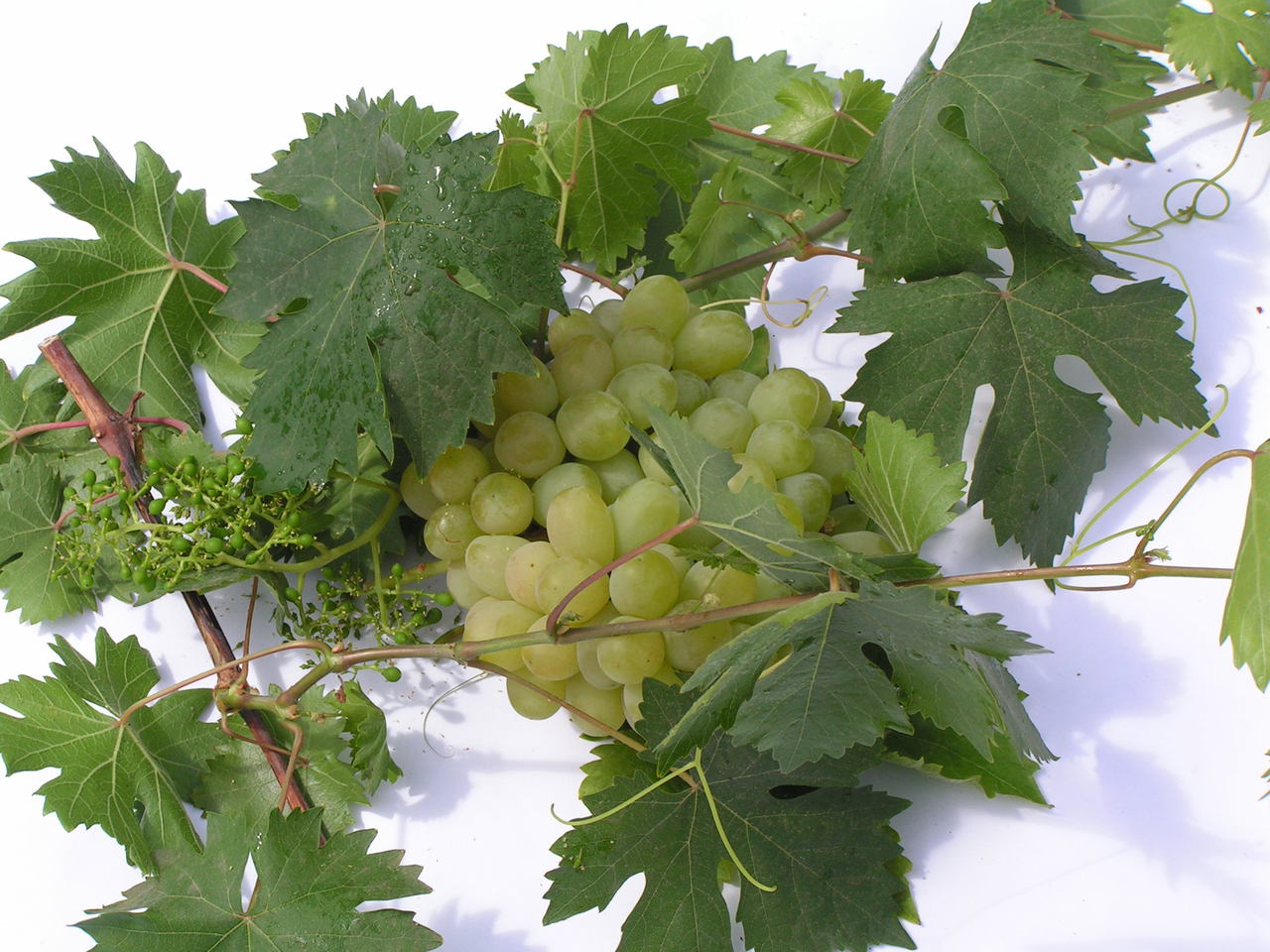 Grapes “Aleshenkin” are growing smaller, poorly growing, there is practically no foliage on it? So you made a lot of mistakes in caring for such an unusual grape variety. It is important to know not only about the proper watering, but also how to properly prune, on which the growth and development of the crop depends.
Grapes “Aleshenkin” are growing smaller, poorly growing, there is practically no foliage on it? So you made a lot of mistakes in caring for such an unusual grape variety. It is important to know not only about the proper watering, but also how to properly prune, on which the growth and development of the crop depends.
Content
General characteristics and description
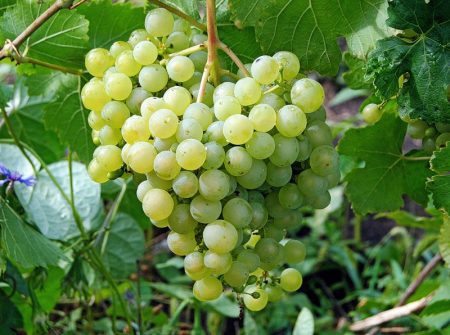 Aleshenkin grapes were bred in the middle of the 20th century. He received his unusual name from the agronomist Tsekhmistrenko, who named him after his grandson.
Aleshenkin grapes were bred in the middle of the 20th century. He received his unusual name from the agronomist Tsekhmistrenko, who named him after his grandson.
The variety belongs to the canteens and subject to the rules of agricultural technology, you can collect from one bush up to 25 kg. Compared to other varieties, this is really a lot and allow not only to feed the family, but also leave some for sale. “Aleshenkin” is thermophilic and tolerates drought. Therefore, it is most successfully taking root in the south of the country with a long summer. The main distinguishing feature is the almost complete absence of seeds in the berries.
Shrub "Aleshenkin" tall, abundantly covered with foliage. The color of the leaves is emerald-light, and the size does not exceed the average foliage of the grapes. The surface is smooth, glossy. Each shoot forms bisexual flowers that do not need additional pollination. To carry out the correct pruning without harming the grapes, it is worth noting that one vine lives for about 4-6 years, and when pruned, it quickly takes root on new land.
The variety belongs to early ripening - to achieve biological maturity it needs about 110-130 days and you can get the first crop in July. The weight of one brush can reach 2000 g. The berries are of a classic shape, and the brush resembles a cone. The approximate weight of one berry is 5 g. The color is close to amber. Bones will not prevent you from enjoying the sweet taste, as they are simply absent. The most common use is fresh consumption. It is possible to make juices, compotes and wines.
The yield value may vary depending on weather conditions and the climate of your region.
Advantages and disadvantages of the variety
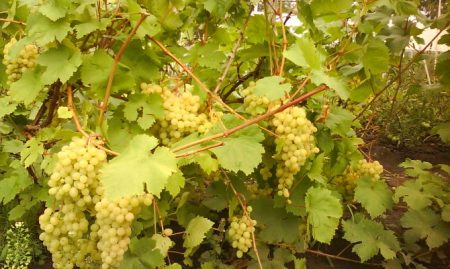 Based on these data, you will be able to determine whether the grade “Aleshenkin” is suitable for you.
Based on these data, you will be able to determine whether the grade “Aleshenkin” is suitable for you.
Grade Advantages
- almost complete absence of seeds;
- short ripening;
- well tolerate transportation;
- long shelf life;
- unpretentiousness to growing conditions;
- bears fruit for a long time;
- tolerates high temperatures, aridity of soils.
Grade Cons
- high sugar content - more than 20% (contraindicated for people with diabetes);
- the lower parts of the bushes do not tolerate frosts, which can lead to the death of brushes;
- in case of non-observance of the rules of cultivation and insufficiency of useful microelements, it is prone to peeling - a reduction in the size of grapes;
- low resistance to fungal and viral diseases.
Pollination
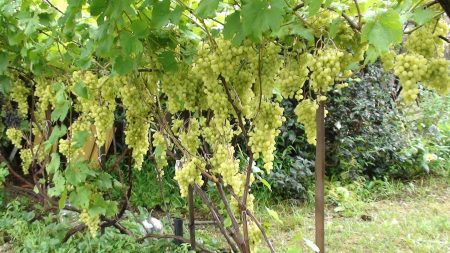 Due to the fact that grapes form flowers of both sexes on the branches, this variety does not need pollination. This is a definite plus, especially for those garden plots where, due to the climate, there is a shortage of biological pollinators. It’s not worth trying to provoke additional pollination, this will not affect the crop in any way.
Due to the fact that grapes form flowers of both sexes on the branches, this variety does not need pollination. This is a definite plus, especially for those garden plots where, due to the climate, there is a shortage of biological pollinators. It’s not worth trying to provoke additional pollination, this will not affect the crop in any way.
Resistance to diseases and pests, adverse conditions
Aleshenkin does not have high immunity, therefore, he is often attacked by fungal and viral diseases. Therefore, it is so important not only to learn in time to identify signs of infection, but also to know how to deal with it.
| Disease | Signs | How to treat? |
| Downy mildew | The appearance on the surface of leaves of oily yellow spots, gradually covering the entire bush. It is fraught with a coating of white fluffy plaque and death of grapes in a running situation. | Every 10 days, treat with Bordeaux liquid, remove weeds in a timely manner and mulch the bed space. |
| Alternariosis | Appearance of olive-dark spots on the inside of the leaf. With increased activity of the pathogen - the leaves curl and turn into dust. Grapes are also subject to spoilage: they crack and change their taste. The processes cease to ripen and die with minimal frost. | If signs of infection are found, treat with copper sulfate or Bordeaux fluid. Do not forget about pruning the affected leaves and processes and the application of mineral fertilizers that increase immunity and resistance. |
| Cercosporosis | Outwardly similar to powdery mildew, but the spots are smaller, and the disease affects almost the entire bush. The reason is increased humidity. | Treat with 1% Bordeaux fluid and fertilize. with the highest nitrogen content. Watering must be reduced to 4 times a month. |
| Armillariosis | A disease that affects the roots of grapes leading to death. As a rule, it begins to develop in the spring, and autumn, with the final defeat of the bush, yellow mushrooms grow on it. | Can not be treated. There is only one way out - uproot the bush, and treat the ground with fungicides. During the year, the bed will be prohibited from being used for planting .. |
| Aspergillus Rot | The reason is increased air temperature. It affects grapes. covering them with a white coating, gradually covering with pressed dark spots. Fungi become the cause of the development of Drosophila fly larvae. | Can not be treated. The only way out is to remove the affected berries or bush with an advanced stage. |
| Powdery mildew | White coating of two sides of the leaf, deformation of the edges of the leaf, color change from green to brown-yellow, the death of processes. | Every two weeks, feed bushes with mineral fertilizers with the highest content of phosphorus and potassium. Treat bushes with Topaz solution, and cut off and burn all affected areas. Tools - treat with alcohol or using fire. |
| Chlorosis | It occurs due to a lack of iron. It is expressed in stopping the growth of the bush and the cessation of its development. | Make a complex of mineral fertilizers with the highest iron content. Use “Chelate” as a treatment agent. If lemon stains are found, perform Actara treatments. |
It is strictly forbidden to carry out processing during the period of fruit formation - it negatively affects the quality of the fruit and human health.
Features of agricultural technology varieties
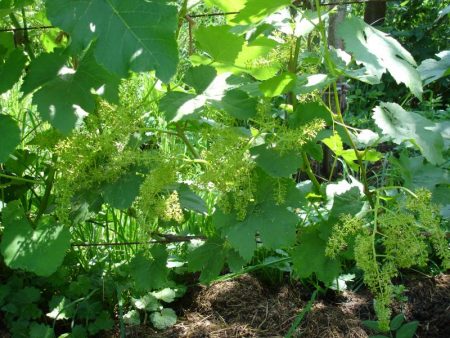 Compliance with growing conditions is the key to obtaining a high-quality and plentiful crop.
Compliance with growing conditions is the key to obtaining a high-quality and plentiful crop.
Favorable conditions
“Aleshenkin” tolerates hot sunny weather, but do not grow it in the middle of the site. The place should be ventilated, but without drafts. It is important not to break the vineyard under groundwater, which can lead to the death of bushes. If you decide to plant grapes near the house, then back away from the foundation about 7 meters. A necessary measure - the roots grow rapidly, and it will be impossible to uproot them without damaging the foundation of the house. Grapes do not like excessive humidity, on the contrary, a little dryness will do good. To obtain seedlings, it is better to choose unheated film-type greenhouses with the possibility of daily ventilation. Seedlings are purchased ready, so it makes no sense to talk about growing conditions.
Grape growing
It is best grown by seedlings or cuttings. In the fall, prepare the land, dig, fertilize it with a mineral complex. In the spring, dig a hole with a depth of not more than 80 cm and a width of 70. Mix the earth with humus, 50 gr. superphosphate and nitrophosphates. To soften the soil, add some river sand.
Place the grapes in the pit, cover half with the mixture described above and pour warm water. Pour the rest of the mixture on top. The kidney should be buried just below ground level. To create greenhouse conditions, cover the stalk with a transparent film, making a small hole on top, through which the seedling will later grow. Remove the film periodically and check the condition of the soil. It is completely recommended to clean it in August.
Watering grapes “Aleshenkin”
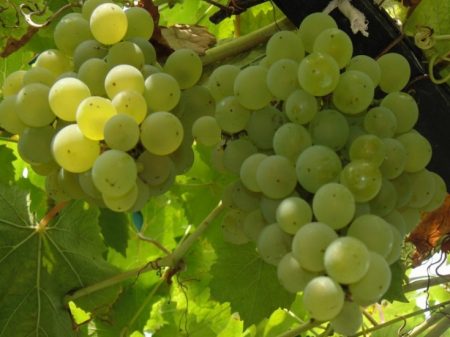 Due to active growth, seedlings need watering once every 2 weeks. As a rule, 5 buckets are enough for one 80 * 70 bed. Before each watering, check the soil - if it is excessively moistened, and the watering period has come, it is better to transfer it for several days.
Due to active growth, seedlings need watering once every 2 weeks. As a rule, 5 buckets are enough for one 80 * 70 bed. Before each watering, check the soil - if it is excessively moistened, and the watering period has come, it is better to transfer it for several days.
Watering is stopped at the stage of formation of flowers and buds. Violation of the ban will lead to the falling of flowers and the reduction of grapes on the vine. Watering is prohibited at the stage of acquisition by the grapes of softness - excess moisture leads to cracking of the fruit.
Bush formation
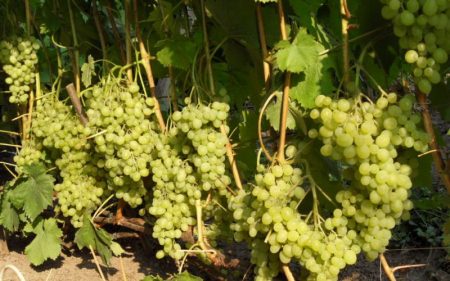 From a biological point of view, it would be most appropriate to let the grapes trail along the fence or pergola. At the stage of growth of seedlings, it is best to tie to trellises or stakes with the help of kapron rags. When deforming the shape you need, cut off excessively large processes, trying to maintain as much green mass as possible.
From a biological point of view, it would be most appropriate to let the grapes trail along the fence or pergola. At the stage of growth of seedlings, it is best to tie to trellises or stakes with the help of kapron rags. When deforming the shape you need, cut off excessively large processes, trying to maintain as much green mass as possible.
Cropping Features
Pruning can be carried out only 3 weeks after the leaves fall. To invest in shelter in the winter, use the fanless, stampless method. In the first year you need to get a strong escape. In the autumn, cut it so that no more than 2 eyes remain from the soil level. The following year, on the long shoots that grew from these buds, cut into two short shoots - knots of substitution. In this case, leave 2-3 eyes and one long process. It will act as a fruiting vine.
With fruiting in subsequent years, you will be able to adjust the length of the shoots yourself, thereby independently controlling the degree and length of fruiting. In the fall, cut the entire fruiting vine to the highest possible level, that is, to the knot. Next year, repeat all steps again.
Preparation for winter
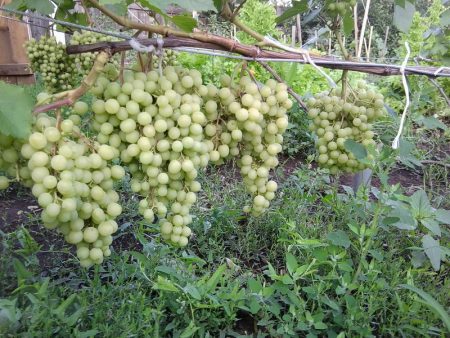 In addition to pruning, grapes in winter need shelter. The most common cover material is spruce branches or simply coniferous branches. They need to cover the bush 40 cm in height. This method will not only protect the roots from frost, but will not allow excessive moisture to form, it will protect against insects. Coniferous branches can be replaced with straw, and if you live in the northern regions, then you can cover the bushes with a greenhouse film.
In addition to pruning, grapes in winter need shelter. The most common cover material is spruce branches or simply coniferous branches. They need to cover the bush 40 cm in height. This method will not only protect the roots from frost, but will not allow excessive moisture to form, it will protect against insects. Coniferous branches can be replaced with straw, and if you live in the northern regions, then you can cover the bushes with a greenhouse film.
Before hiding, apply to the soil:
- in early September - manure, humus or other organic substances;
- in October - potassium;
- in November (last top dressing) - a mixture of 20 gr. superphosphate, 10 gr. potassium salt, 1 gr. boric acid, 2 gr. zinc sulfate mixed with 10 liters of water.
Reviews of those who planted
Igor
“The grapes were grown for the first time and, as it seemed to me, I tried to do my best to preserve the bush. Of course, about pruning, and even under the knots I did not want to hear. As a result, the whole crop resembles peas rather than grapes. Later I read that all those branches that gave the crop must be cut. It will only benefit the bush, and the fruit will become larger. ”
Olga
“The grapes rotted a few seasons ago on the site. I searched for a reason for a long time. And only then drew attention to the frequency of watering. I watered 2 times a week, all afraid that the variety would dry out. As a result, it has become soaked. This season I water bushes no more than 4 times a month. ”
Grapes, despite all the difficulties in care, are unpretentious. With proper care, he will not only delight you with his harvest, but also help to transform part of the garden plot at no additional cost.




 Non-covering winter-hardy grape varieties for Moscow region
Non-covering winter-hardy grape varieties for Moscow region How to keep the vine in winter
How to keep the vine in winter When can I transfer grapes to another place in the fall
When can I transfer grapes to another place in the fall How to cover and prepare grapes for the winter in the suburbs
How to cover and prepare grapes for the winter in the suburbs